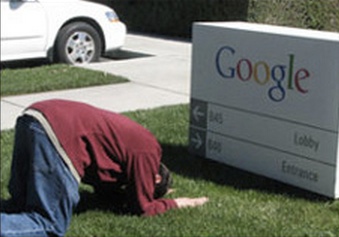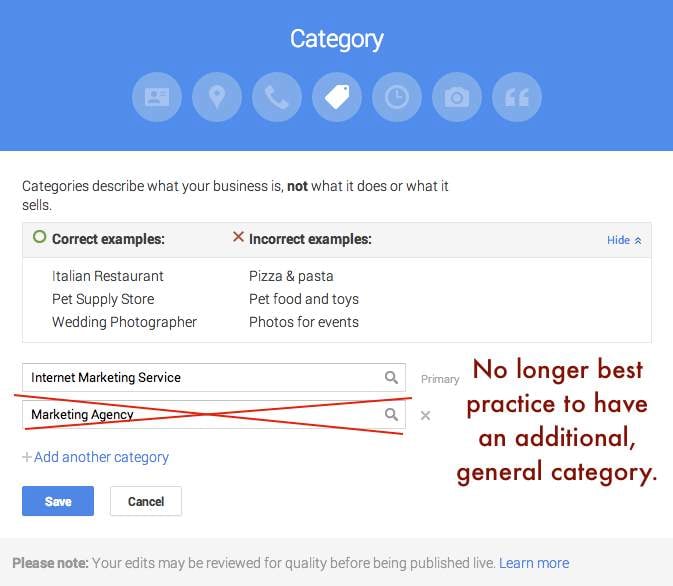Old Google Plus Guidelines Go Out Of Business
December 3rd, 2014 by


Descriptors in the Business Name Are NOT Allowed
Back at Pubcon last year, I heard a lot about how to use descriptors and why you should be using them. While in theory it’s a great idea, when asked if we should be using this in house, my thought was that it ruins the principle of NAP (Name, Address, Phone Number) consistency across the web and that Google probably wouldn’t stick with it. Sure enough, this was one of the changes two nights ago.
Before:
In addition to your business’s real-world title, you may include a single descriptor that helps customers locate your business or understand what your business offers.
Now:
Your name should reflect your business’ real-world name, as used consistently on your storefront, website, stationery, and as known to customers. Any additional information, when relevant, can be included in other sections of your business information (e.g., “Address”, “Categories”).
Note the word “consistently” in the new guidelines. The examples Google gives in the new guidelines say you can’t include the following in your business name:
- taglines
- store codes
- trademark signs
- unnecessary all caps
- hours info
- phone numbers or websites
- special characters (e.g. %&$@/”) or legal terms (e.g. LLC Ltd) – unless part of your real name
- services or products
- location information
My advice is to pick an official business name and stick to using it everywhere. Avoid punctuation if possible, because it just provides another opportunity for inconsistency.
BAD: Starbucks Downtown
GOOD: Starbucks
Importance of Name & Category Consistency for Chains & Brands
Now:
All business locations within the same country must have the same name for all locations.
All locations of a business must share the one category that best represents the business.
Along the same lines of not using unique descriptors, if your business has multiple locations, the name and categories of their pages should reflect the same information. Note that there are instances of when variances are acceptable to Google that you can read more about within the guidelines.
BAD: Location #1 – Name: The Search Influence, Location #2: Search Influence
GOOD: All Locations – Name: Search Influence
BAD: Search Influence Page #1 – Category: Advertising Agency
Search Influence Page #2 – Category: Internet Marketing Service
GOOD: All Search Influence Pages – Category: Internet Marketing Service
Categories Must Be As Specific As Possible
Before:
Select at least one category from the list of available categories.
Now:
Use as few categories as possible to describe your overall core business from the provided list. Choose categories that are as specific as possible, but representative of your main business.
This is one that will mostly affect major niches like doctors and lawyers, as there are a lot of general terms that could apply to these types of businesses. In the example above where I showed Search Influence with the categories Advertising Agency and Internet Marketing Service, our more specific category would be the latter. Adding Advertising Agency as an alternate would not be best practice.
BAD: NOLA Hospital – Categories: Hospital, Children’s Hospital, Doctor, Surgeon
GOOD: NOLA Hospital – Categories: Children’s Hospital


Departments Within One Location Must Have Unique Categories
Before:
Departments within businesses, universities, hospitals, and government buildings may be listed separately. These departments must be publicly distinct as entities or groups within their parent organization, and ideally will have separate phone numbers and/or customer entrances. Businesses that operate in a service area, as opposed to a single location, should not create a page for every city they service.
Now:
Publicly-facing departments that operate as distinct entities should have their own page. The exact name of each department must be different from that of the main business and that of other departments. Typically such departments have a separate customer entrance and should each have distinct categories. Their hours may sometimes differ from those of the main business.
If you choose to represent the various departments of your business through multiple pages in Google My Business (e.g. Hospitals, Schools), each page should have a unique department. Also, as per normal Google guidelines for multiple pages at one location, each page should have some unique location identifier, which would be either a unique suite number/address or a unique phone number.
BAD: NOLA University – Category: College
NOLA University Cosmetic Surgery Department – Category: College
GOOD: NOLA University – Category: College
NOLA University Graduate School – Category: Graduate School
Multiple Brands At One Location Must Choose ONE Name
Now:
If your business location combines two or more brands, do not combine the brand names into a single page. Instead, pick one brand’s name for the page. If the brands operate independently, you may use a separate page for each brand at this location.
The examples Google gives for this update seem to pertain to places like fast food restaurants where, for example, a KFC and Taco Bell are in the same building. In that instance, a page called “KFC / Taco Bell” would not be acceptable, and they would have to have two separate pages if they’d like to represent both business names.
At first, I thought this might affect car dealerships that use multiple business names for multiple pages but are at the same location. However, as long you have separate pages for multiple “brands” at the same location, you should be fine. It is important to note that multiple businesses at the same location need at least one form of unique location identifiers, whether it be a different phone number for each brand at the one location or a different suite number for each brand at the one location.
BAD: Page #1 – Name: KFC / Taco Bell
GOOD: Page #1 – Name: KFC Page #2 – Taco Bell
BAD: Page #1 – Mary’s Jeep, 935 Gravier Street, New Orleans, LA (504) 208 – 3900
Page #2 – Mary’s BMW, 935 Gravier Street, New Orleans, LA (504) 208 – 3900
GOOD: Page #1 – Mary’s Jeep, 935 Gravier Street #1300, New Orleans, LA (504) 208 – 3900
Page #2 – Mary’s BMW, 935 Gravier Street #1301, New Orleans, LA (504) 208 – 3900
No Practice Name in Practitioner Names of Multi-Location Practices
Now:
If the practitioner is one of several public facing practitioners at this location:
The organization should create a page for this location, separate from that of the practitioner.
The page for the practitioner should be titled with name of the practitioner only, excluding that of the organization.
The reason the now improper formatting is bad practice is that it impedes the user experience and could prevent someone from finding the page they’re looking for if practitioners with the practice name in their name are showing up in practice search results. This needs no further explanation in my opinion, so straight to examples.
BAD: NOLA Cosmetics: Mary Silva
GOOD: Mary Silva
Solo Practitioner Name Formatting
Now:
If a practitioner is the sole public-facing one at this location and represents a branded organization, the practitioner page should not be separate from the organization’s page. Instead, create a single page, titled using the following format: [brand/company]: [practitioner name].
Along the same lines of the last guideline, to help users find this type of business, practitioners who own a branded practice and are the only practitioner of said practice should have just one page that combines their name with the branded name.
BAD: Page #1 – NOLA Cosmetics Page #2: Mary Silva
GOOD: ONE PAGE – Nola Cosmetics: Mary Silva
What Happens If I Get This Wrong?
Some of these guidelines appear to be less enforceable than others, in my opinion. So I’d say it’s best to adhere to them and get your pages fixed as soon as possible. If it’s something like pages that appear to be duplicates because there are multiple businesses at the same location with matching info (matching category or matching phone and address), it might get flagged by Google’s algo as a duplicate page violation, but only time will tell how strictly these changes will be enforced.
If you’d like to see the old version of the guidelines to compare them to the new, my way of doing this was to use the Internet Archive Wayback Machine and look at the guidelines page on November 30, 2014. Also, Mike Blumenthal provided a concise, comprehensive list of these updates in his blog!
Hope my thoughts and these examples help. Good luck in all of your Google My Business endeavors! Also, thank you to Amanda DiSilvestro at business2community.com for the bowing to Google image.

